Kitchen cabinets are more than just storage for pots and plates—they define the look and functionality of your cooking space. Whether you’re planning a kitchen remodel or simply updating your existing cabinetry, understanding the various styles and options will help you plan your project. This guide explains everything you need to know about kitchen cabinets, from basic anatomy to modern storage solutions.
Kitchen Cabinet Basics
Understanding the fundamental elements of kitchen cabinets will help you determine the best type for your home. This section will cover the basic structure of a cabinet, common materials, and cabinet construction methods.
Anatomy of a Cabinet
A typical kitchen cabinet has several key components that work together to provide structure and function. These include the following:
- Carcass: The cabinet box that supports the weight of the countertop and items on its shelves
- Corner braces: Keep the carcass square during transport and installation
- Door: The main visible component, available in various styles, such as flat panel, raised panel, slab, and glass front
- Drawer: Moves on metal glides fitted to the sides or bottom
- Face frame: Stiles and rails that stiffen the carcass and provide a mount for hinges (not present with full overlay doors)
- Hinge: Allows the door to open and can be visible or hidden, depending on door type
- Toekick: Closes the gap at the cabinet base and provides a recess for feet
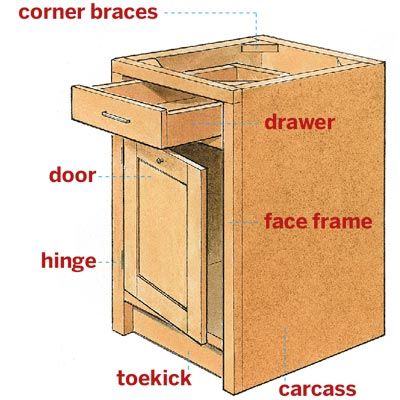
Common Cabinet Materials
Different cabinet materials have different looks, durability levels, and costs. Here are common materials:
- Medium-density fiberboard (MDF): MDF is a composite material made from wood fibers and resin. It’s stable and takes paint well, making it popular for painted cabinets.
- Particleboard: This material uses wood chips and resin. It’s an economical option often used in stock cabinets.
- Plywood: Made from layers of wood veneer, plywood is strong and resistant to warping. It’s often used in higher-end cabinetry.
- Solid wood: Solid wood is known for its natural beauty and durability, making it a great choice for door and drawer fronts. Common species include oak, maple, cherry, and birch.
- Thermofoil: Thermofoil is a vinyl material applied to MDF, offering a durable and easy-to-clean surface.
Cabinet Construction Methods
The way cabinets are constructed affects their strength, durability, and overall quality. Here are some common construction methods:
- Dado joints: Grooves cut into the sides of the cabinet to accept shelves, providing additional strength and stability
- Dovetail joints: A strong, interlocking joint often used in drawer construction, indicating higher quality craftsmanship
- Face-frame construction: A traditional method where a frame is attached to the front of the cabinet box, providing rigidity and a mounting surface for doors and drawers
- Frameless construction (European style): Eliminates the face frame, resulting in a more contemporary look and slightly more interior space
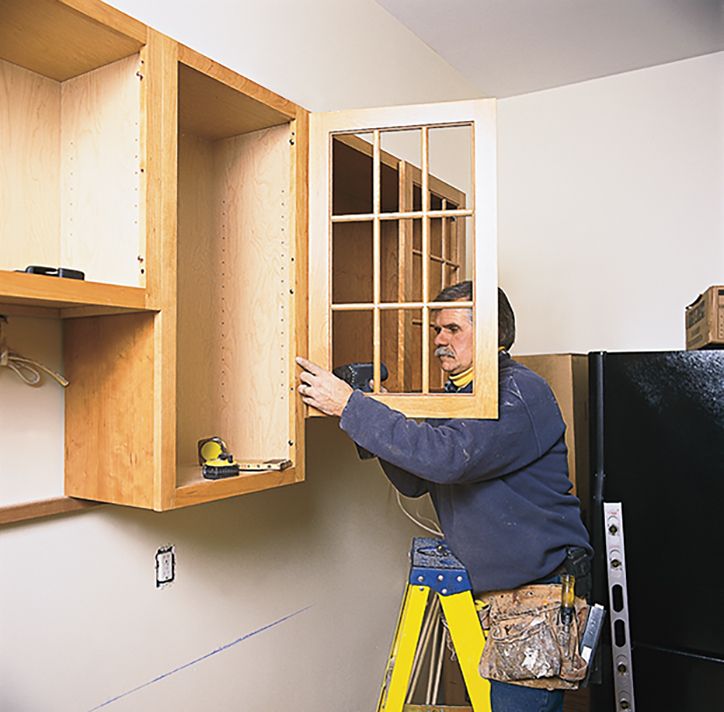
Types of Kitchen Cabinets
When shopping for kitchen cabinets, you’ll encounter three main categories: stock, semi-custom, and custom. Each type offers different levels of customization, quality, and price points to suit various needs and budgets.
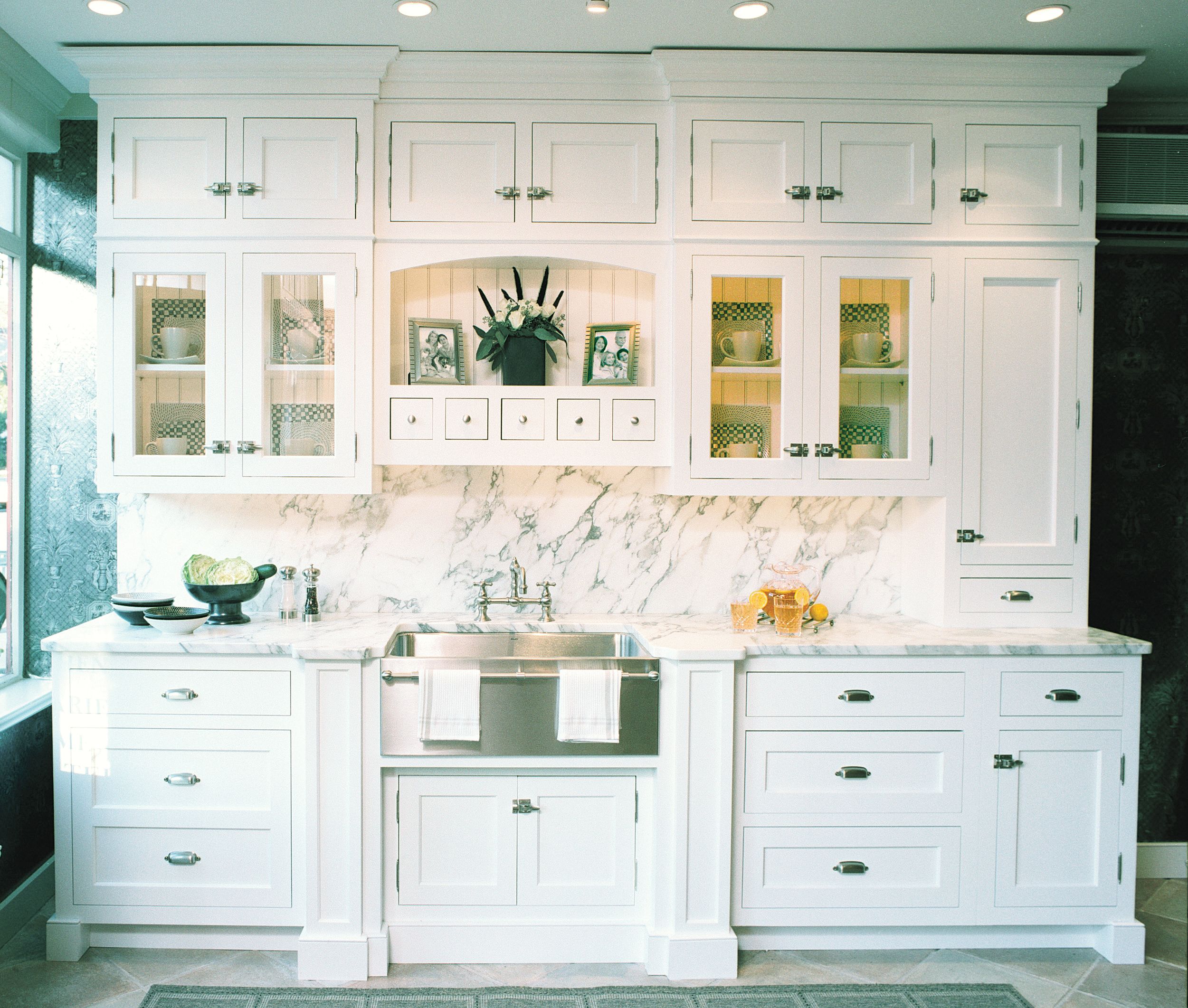
Shown: Custom Colonial door in white-painted plywood; available from Signature Custom Cabinetry.
Stock Cabinets
Stock cabinets are premade in standard sizes and styles, offering the most budget-friendly option for kitchen renovations. They’re often in stock or have short lead times, making them ideal for those on a tight schedule. Home centers and popular retailers usually deliver these within one to five weeks. However, the selection of styles, sizes, and finishes is limited, and stock cabinets may not fit perfectly in your space.
Stock cabinets are usually made with 1/2-inch MDF or particleboard carcasses. The interiors often use melamine, while the exteriors may be finished with thermofoil or wood veneer. These materials make the cabinets more affordable while still providing a decent level of durability. Stock cabinets cost about $35–$81 per linear foot.*
*All cost information in this article sourced from 2024 reports from Angi and CabinetSelect.
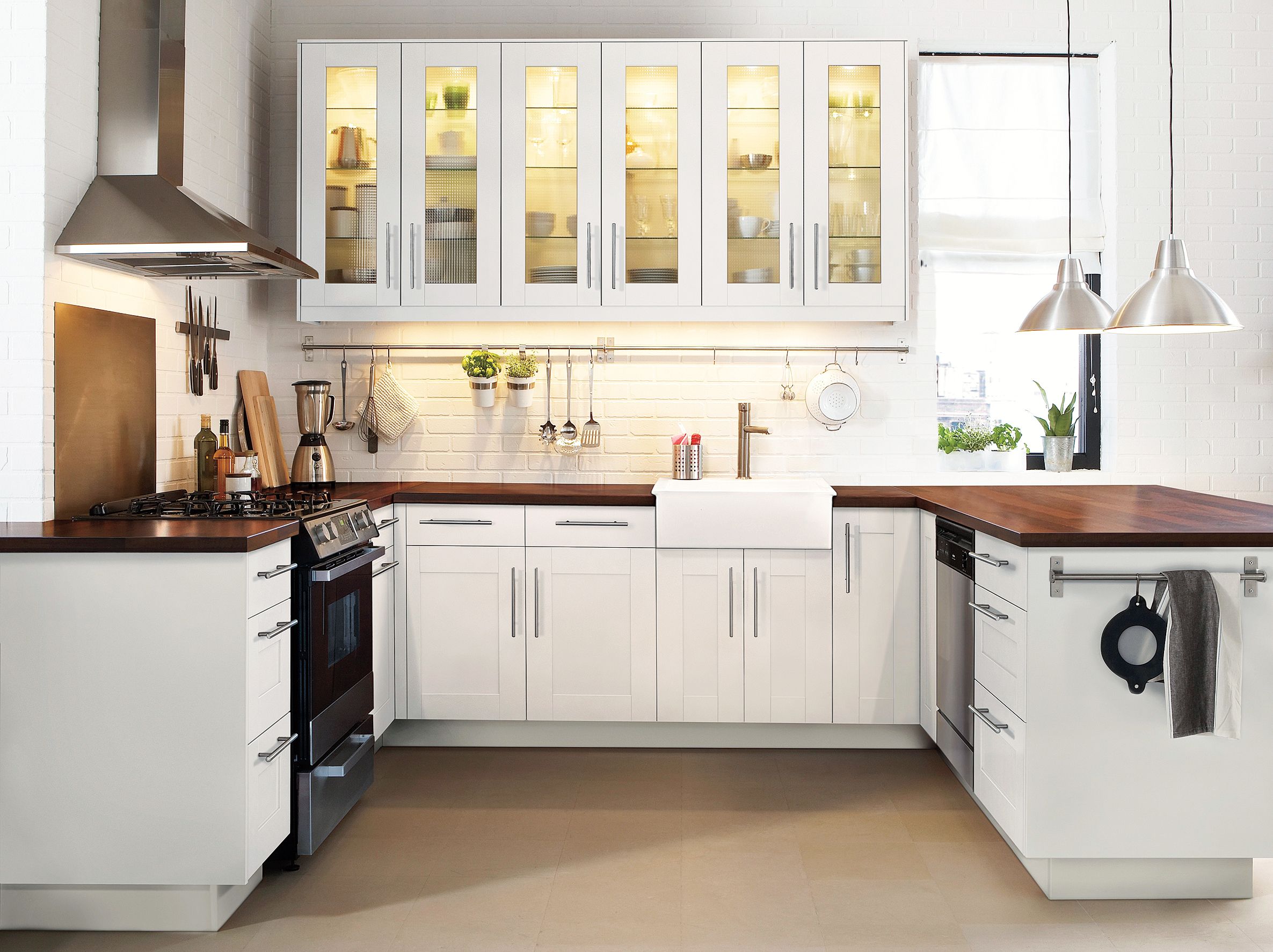
Semi-Custom Cabinets
Semi-custom cabinets are a middle ground between stock and custom options. They offer a greater variety of styles, finishes, and configurations compared to stock options, along with better quality materials. However, they come at a higher cost and still have some limitations for customization. Home centers or kitchen showrooms usually deliver these cabinets within five to six weeks.
These cabinets typically use 1/2-inch MDF for carcasses, with options to upgrade to plywood. Doors may be solid wood or MDF with thermofoil or wood veneer finishes. Semi-custom cabinets range from $90–$650 per linear foot.
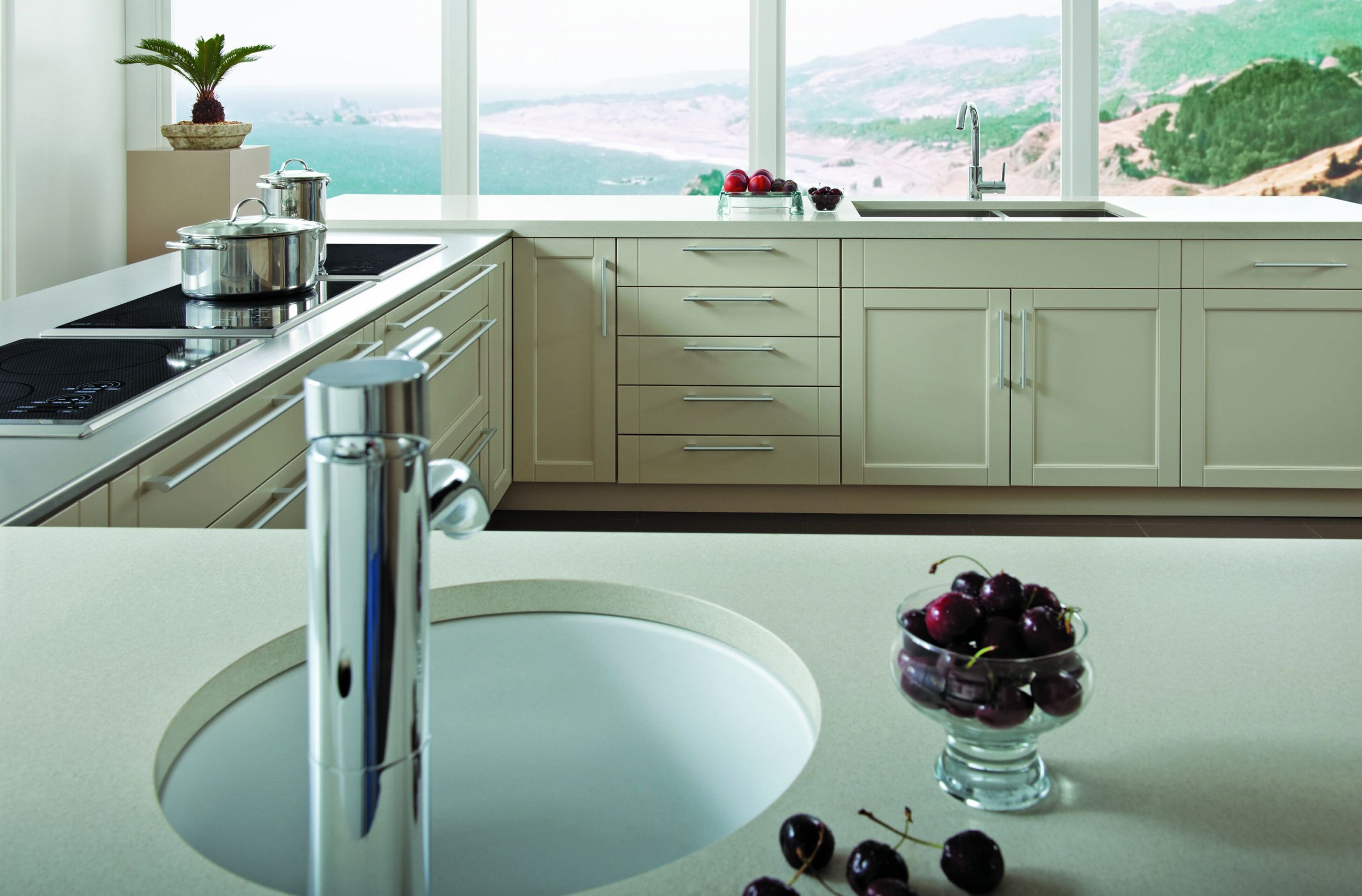
Custom Cabinets
Custom cabinets are the best choice for unique kitchen layouts and specific design visions, but they come at a significantly higher cost with longer delivery times. Lead times can range from eight weeks to six months.
These cabinets typically use 3/4-inch furniture-grade plywood for carcasses and solid wood for the door and drawer fronts. They generally cost $150–$1,200 per linear foot.
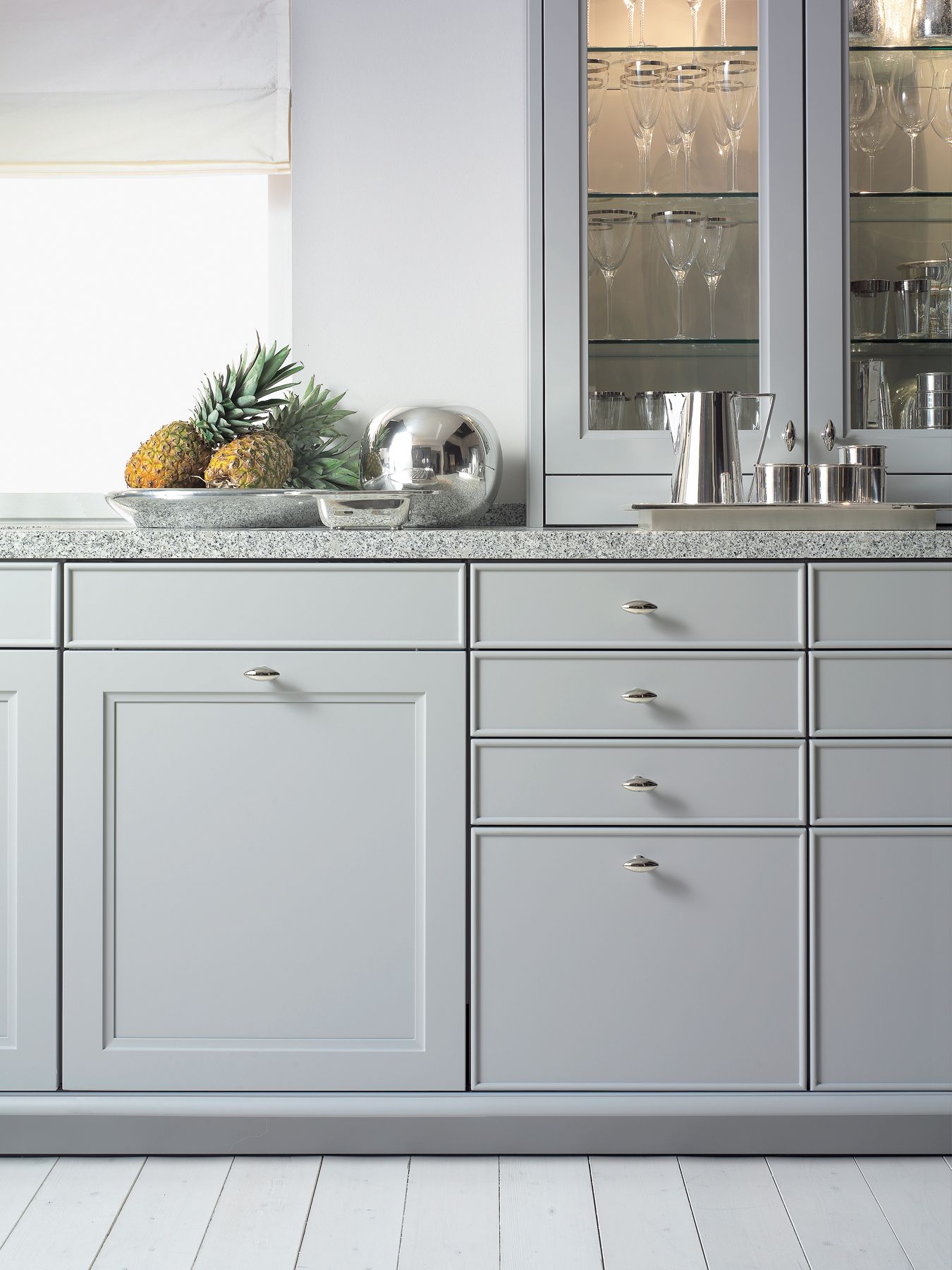
Choosing the Right Cabinet Style
Cabinet styles generally fall into three categories: traditional, contemporary, and transitional. Each has unique visual elements that shape your kitchen’s appearance and function.
Traditional Cabinet Styles
Traditional cabinet styles evoke a sense of warmth and classic elegance, often featuring ornate details and rich finishes. Common types include the following:
- Colonial: Characterized by raised panel doors, warm wood tones, and simple hardware
- Shaker: Typically has a five-piece door with a recessed center panel and simple edges
- Victorian: Typically features elaborate carvings, glass-front doors, and ornate hardware
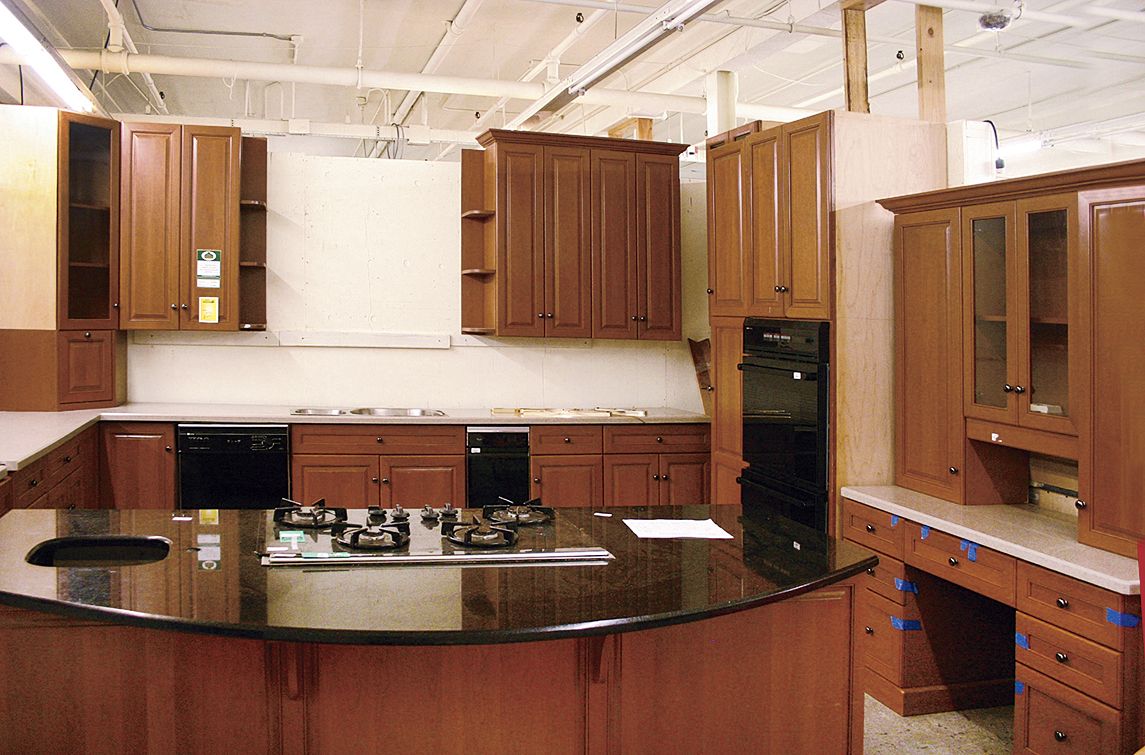
Contemporary Cabinet Styles
Contemporary cabinet styles focus on sleek lines, minimalist design, and modern materials. These are some types of contemporary cabinet styles:
- Flat-panel (slab): Features simple door and drawer fronts without panels or elaborate detailing
- Handleless: Incorporates push-to-open mechanisms or recessed pulls for a streamlined appearance
- High-gloss: Uses lacquered finishes to create a reflective, ultra-modern look
Transitional Cabinet Styles
Transitional styles are perfect for homeowners who appreciate classic and modern design elements and want a flexible, timeless look. Here are common types of this style:
- Beadboard: Combines traditional beadboard paneling with more modern door styles
- Glass-front: Incorporates glass panels into door designs, which can lean traditional or contemporary depending on the frame style
- Modified haker: Features the clean lines of Shaker-style cabinets with subtle modern touches, such as narrower stiles and rails
Design: Victorian
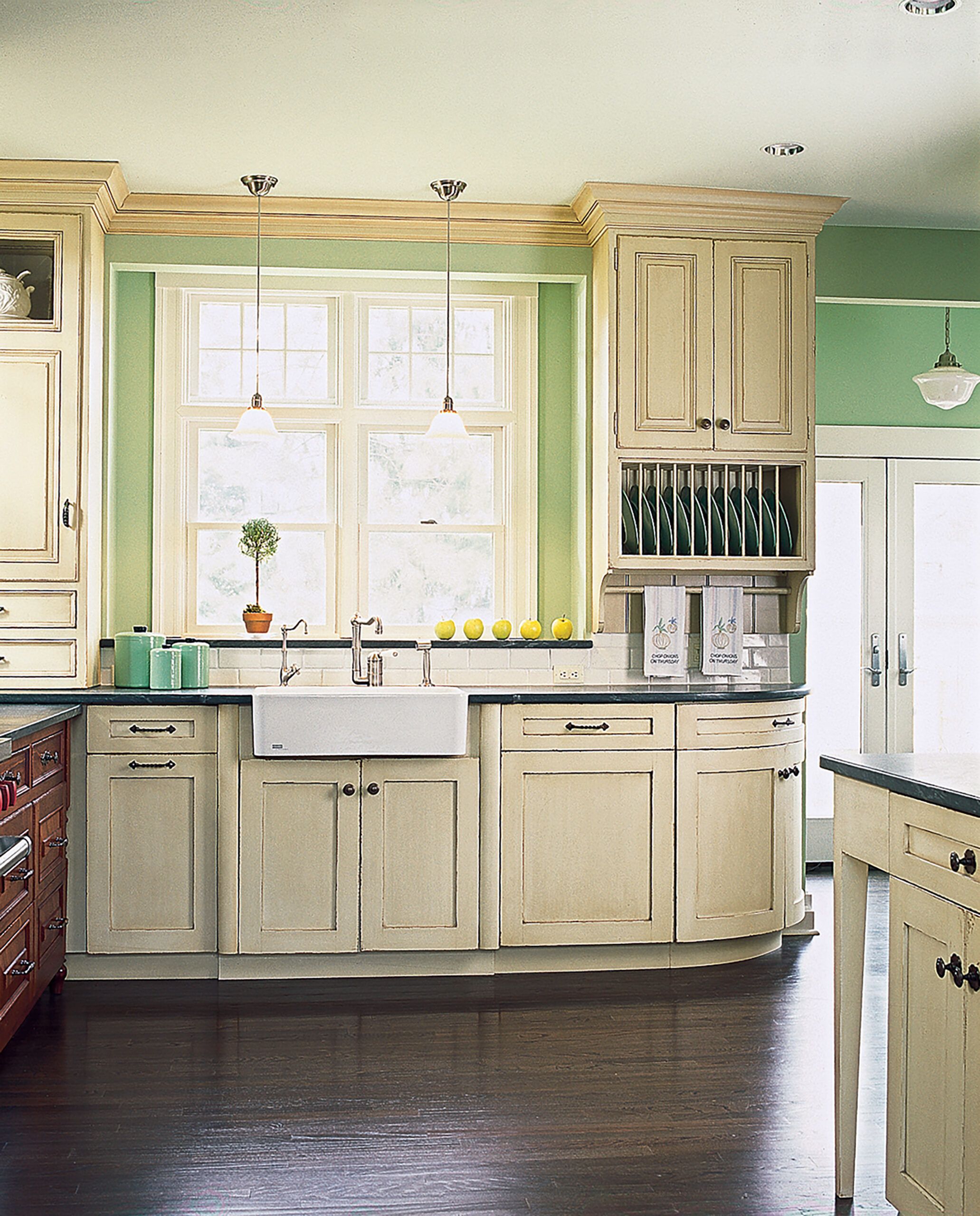
Similar to shown: Semi-custom Classic Portrait in painted maple; available from Merillat
Design: Colonial
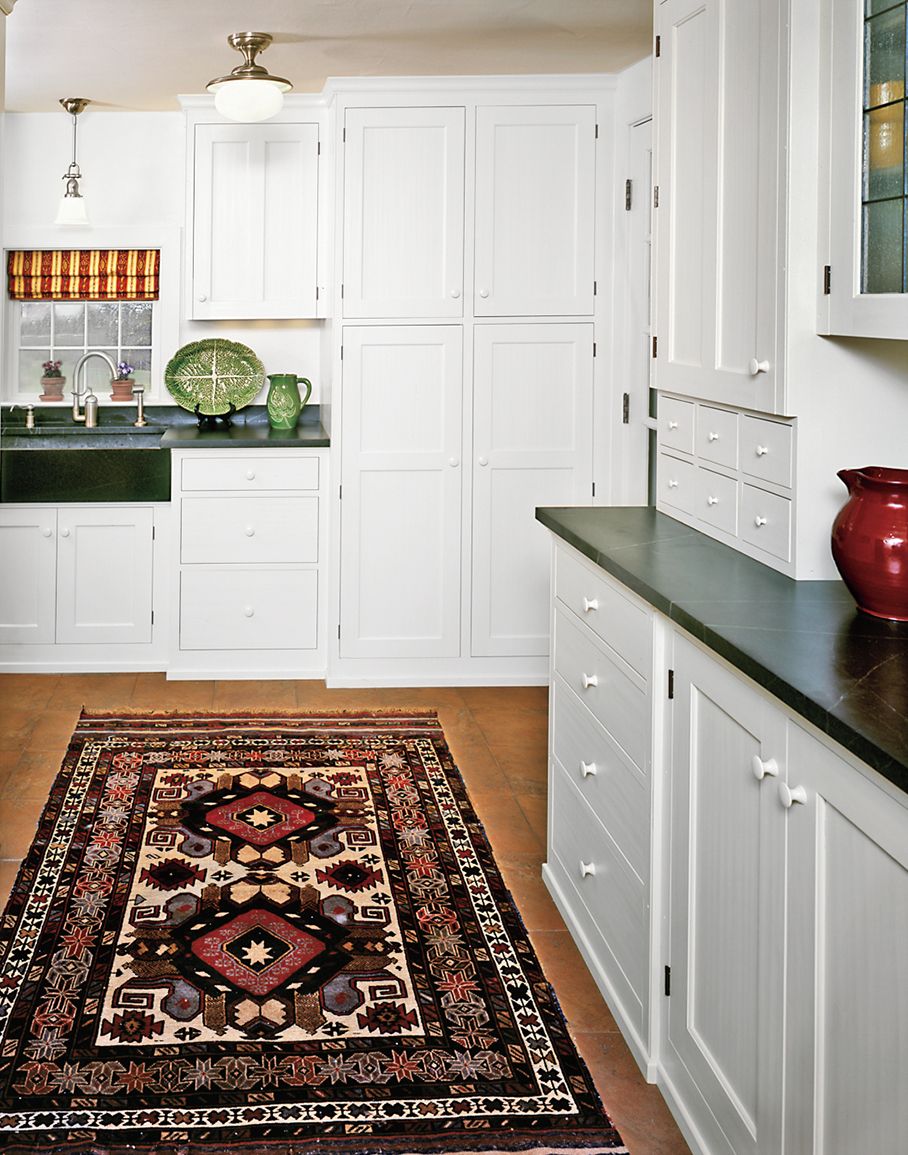
Shown: Custom Shaker in painted white pine; available from The Kennebec Company
Design: Arts and Crafts
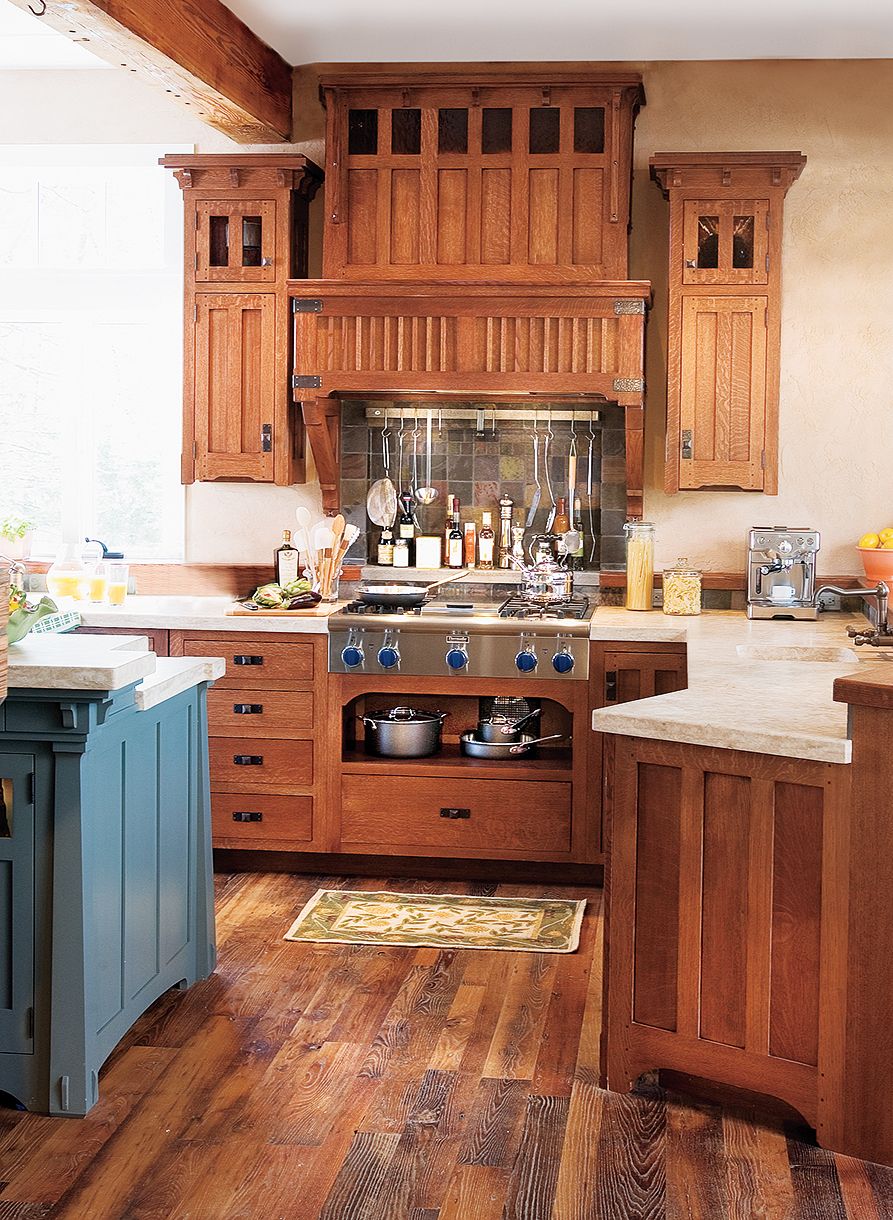
Shown: Custom Arts & Crafts Designer Series in quartersawn white oak; available from Crown Point Cabinetry
Design: Modern
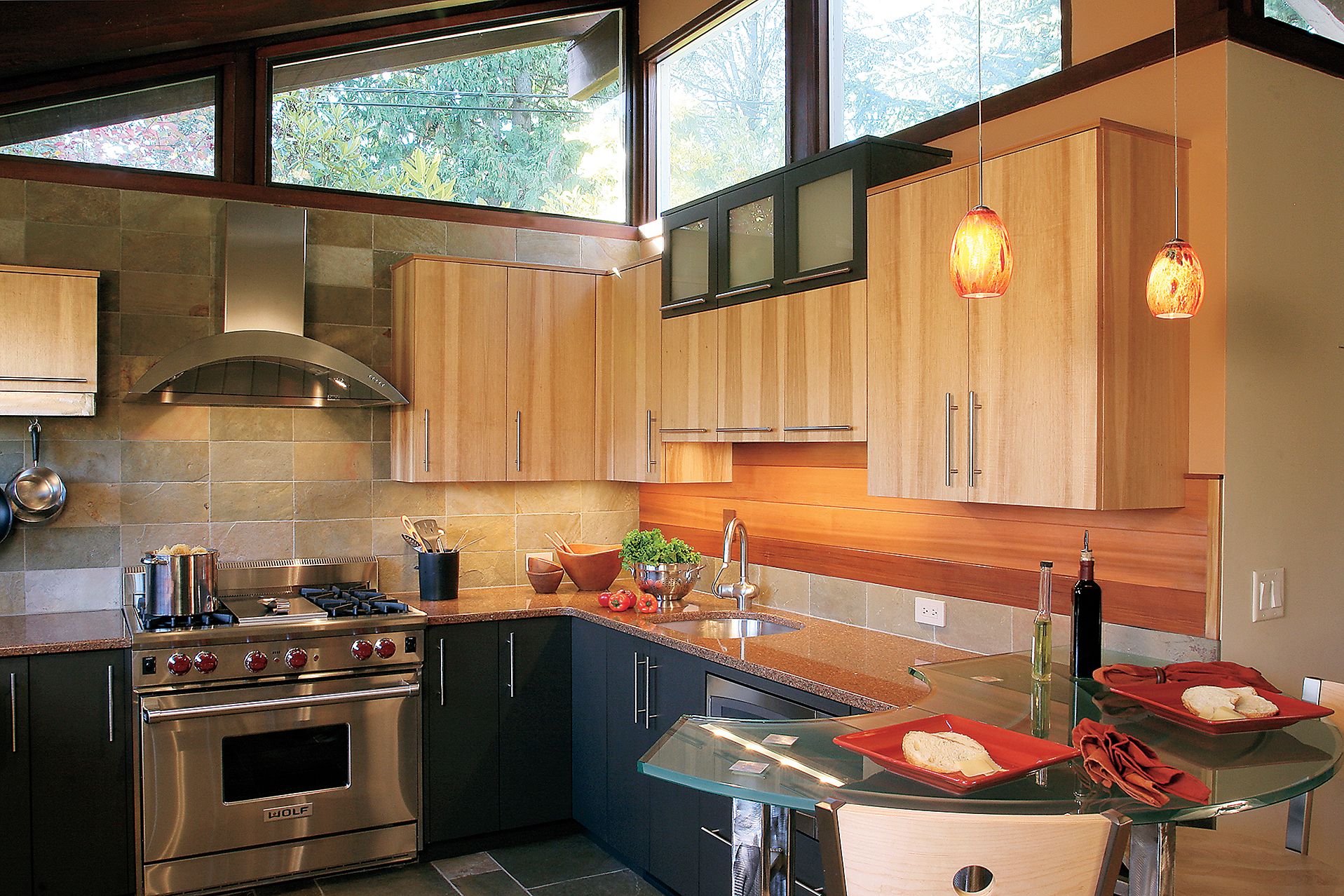
Shown: Custom Mid-Century Modern Collection with hickory veneer over no-formaldehyde MDF; available from Neil Kelly Cabinets
Cabinet Door Designs and Finishes
Different door designs and finishes vary in style, durability, and maintenance requirements.
Popular Door Styles
When selecting a door style, consider how it will complement your overall kitchen design and how it aligns with your taste and lifestyle. Here are some options:
- Beadboard: Beadboard incorporates vertical lines (beads) into the center panel, adding texture and visual interest. Many homeowners use it in cottage or country-style kitchens.
- Flat-panel: This door style features a recessed center panel surrounded by a raised frame. It works well in both traditional and modern kitchens.
- Raised panel: This style has a center panel that rises towards the edges, creating a three-dimensional look. It is often associated with traditional or classic kitchen designs.
- Slab: This sleek style is made from a single, flat piece of material without any panels or decorative details. It’s perfect for modern and contemporary kitchens.
- Glass-front: This style features a glass panel instead of a solid center, allowing you to display items inside the cabinet. It can make a kitchen feel more open and spacious.
Door Style: Beadboard

Shown: Semi-custom Polarcrest door in white thermofoil over MDF, about $150, including 12-by-24-inch cabinet; available from KraftMaid
Door Style: Flat Panel
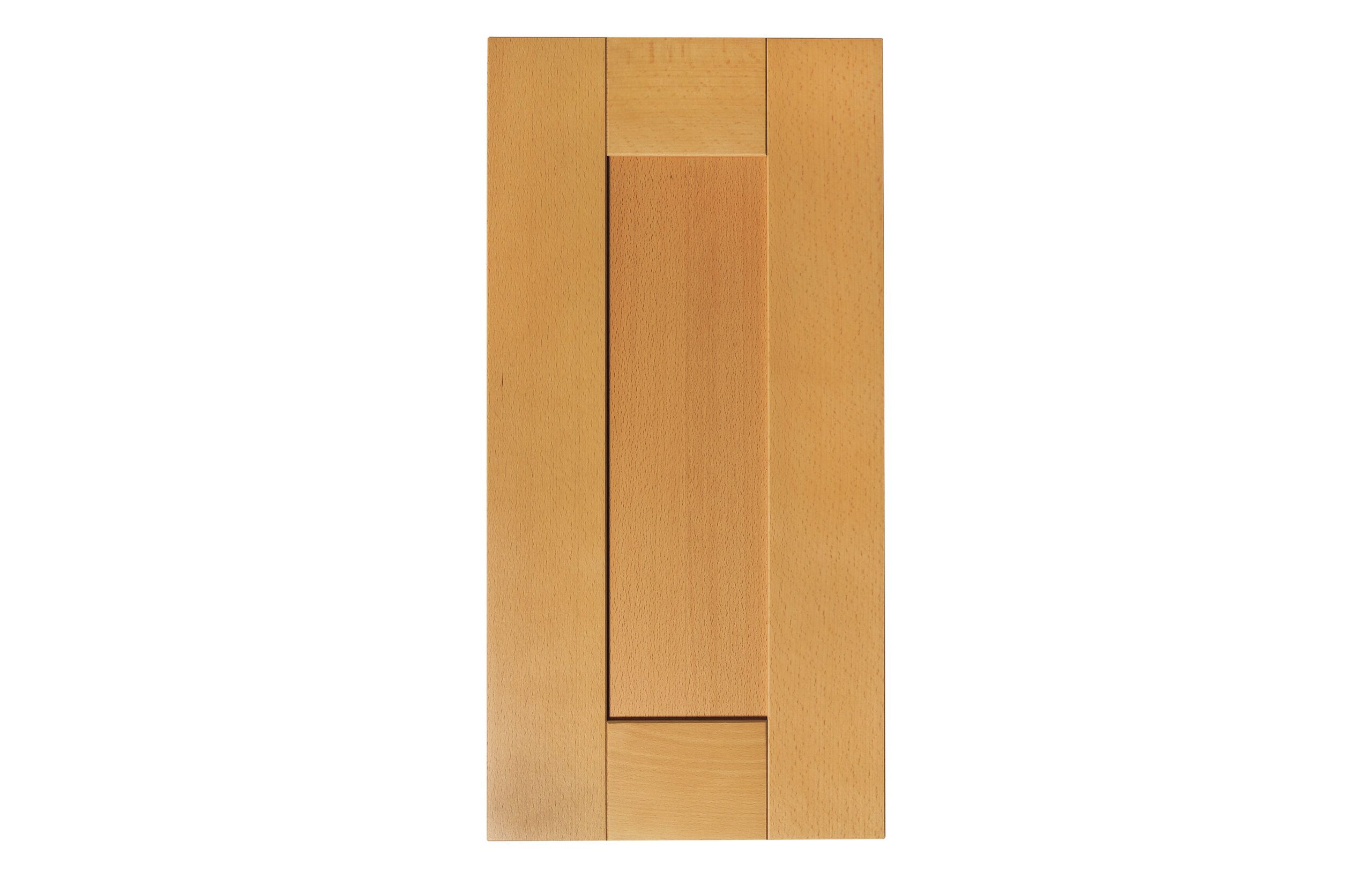
Shown: Stock Adel door in beech veneer over MDF, about $85, including 12-by-30-inch cabinet; available from IKEA
Door Style: Raised Panel
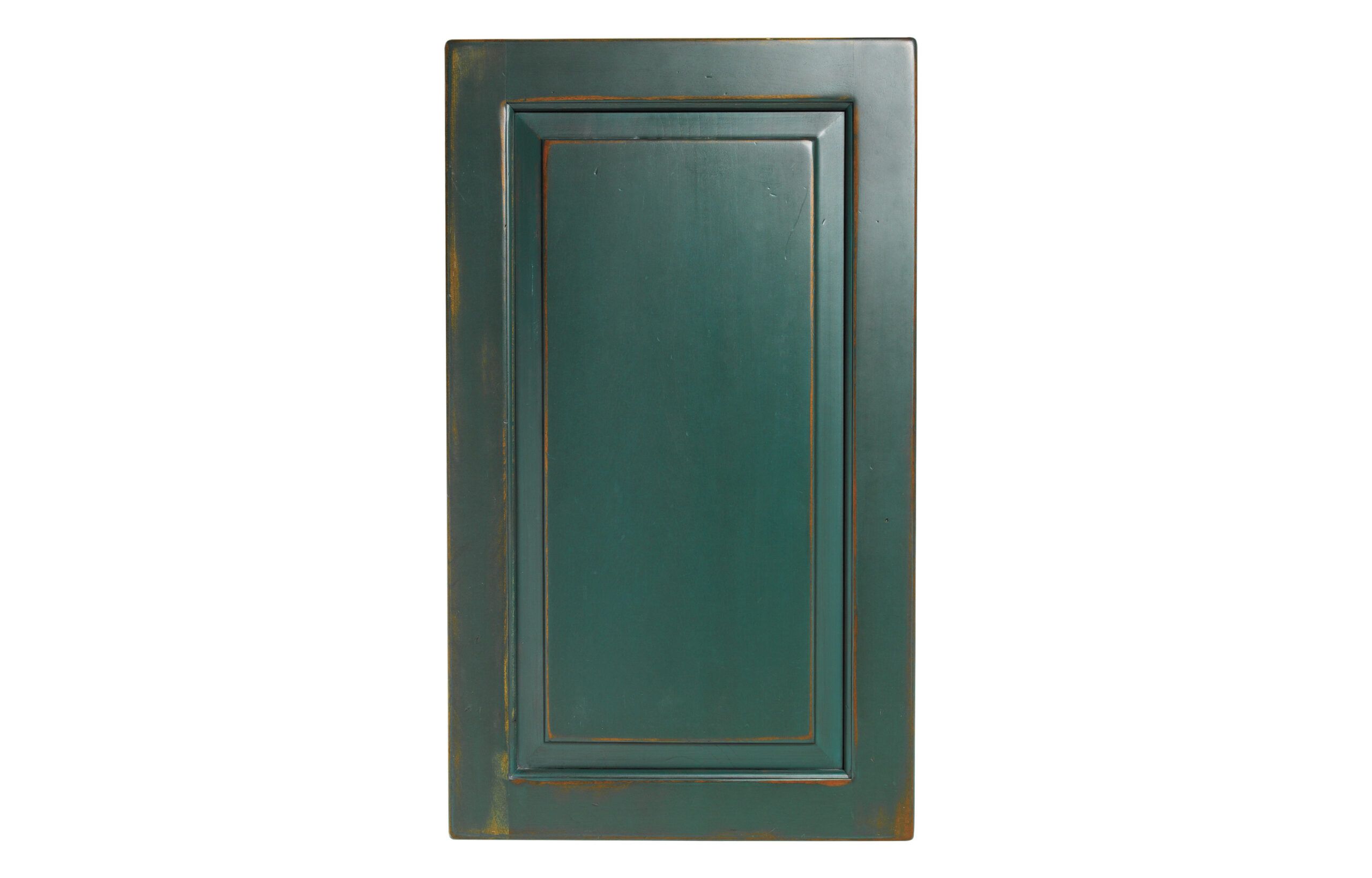
Shown: Custom Vintage door in cherry with distressed paint, about $150; available from Plain & Fancy Custom Cabinetry
Door Style: Slab
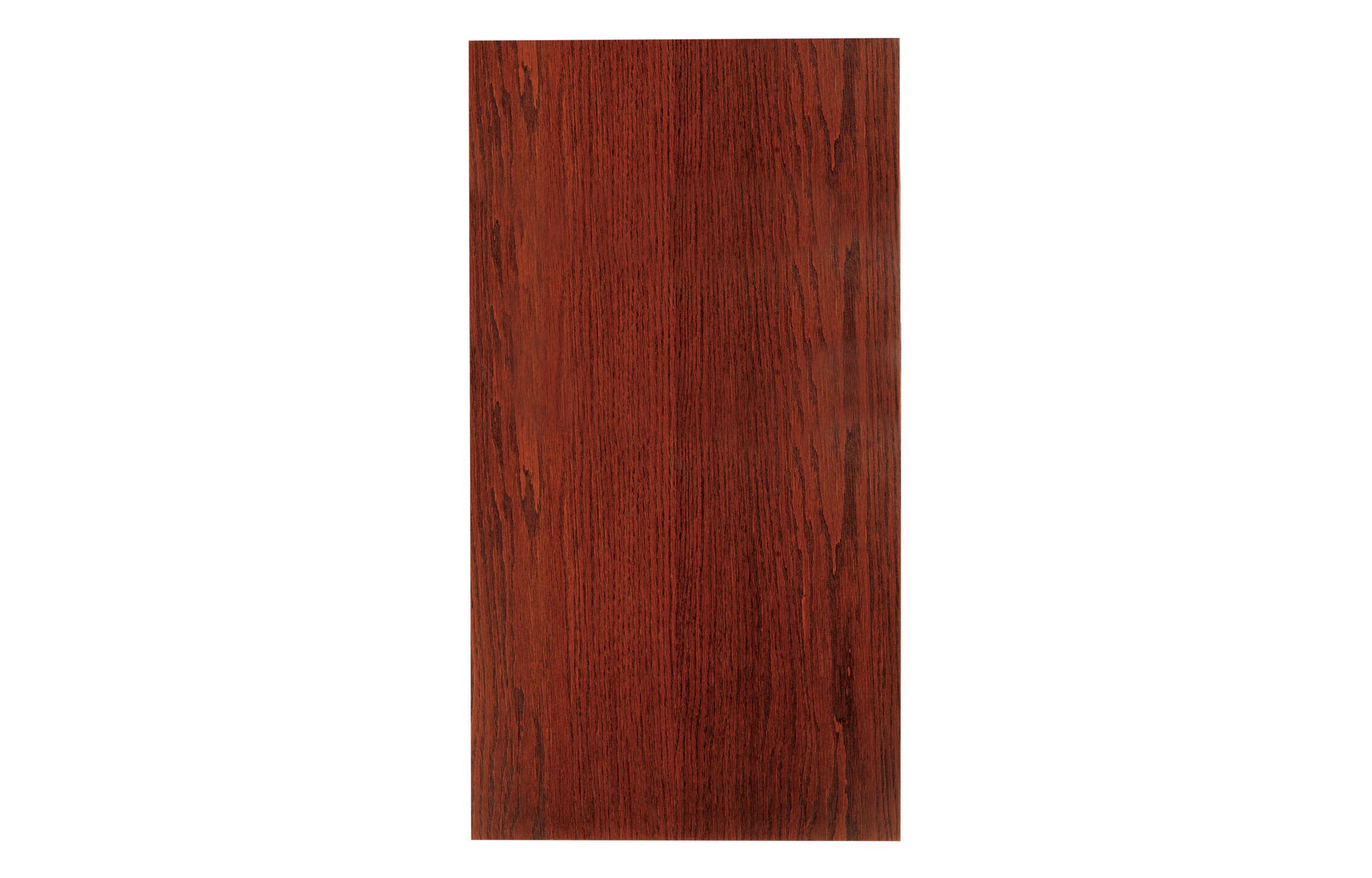
Shown: Semi-custom Vista door in cherry veneer over plywood (Brookhaven II collection), about $225, including 15-by-30-inch cabinet; available from Wood-Mode
Door Style: Glass Front
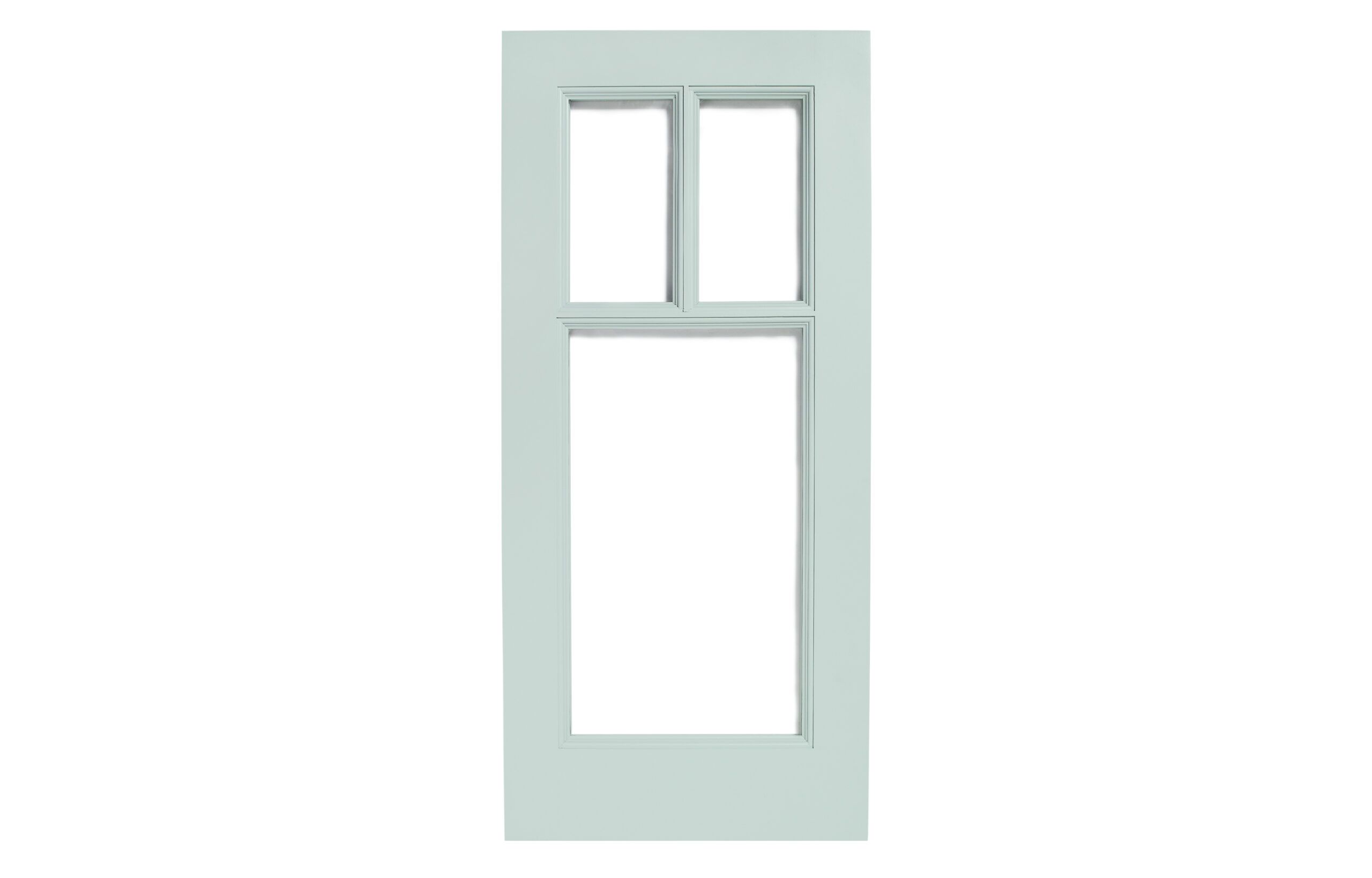
Shown: Custom Chesapeake door in painted maple, about $975, including 15-by-33-inch cabinet; available from Crown Point Cabinetry
Cabinet Finish Options
When choosing a finish, consider its durability, how easy it is to clean, and how well it complements other elements in your kitchen. Lighter finishes can make a space feel larger and brighter, while darker finishes add warmth and drama. These are common finishes:
- Glaze: Creates an antique or weathered look when applied over paint or stain
- High-Gloss: Provides a sleek, reflective surface that’s easy to clean and adds a modern touch
- Matte: Offers a soft, understated look that’s becoming increasingly popular in contemporary kitchens
- Natural Wood: Showcases the wood’s natural color and grain pattern
- Paint: Offers unlimited color options and can easily be updated
- Stain: Enhances the natural beauty of the wood grain and offers a more traditional look
Cabinet Hardware and Accessories
The right hardware and accessories can elevate your cabinets’ functionality and style, including pulls and knob, hinges, and organizational tools.
Pulls, Knobs, and Handles
When selecting hardware, consider the style of your cabinets and your overall kitchen design. For example, ornate brass knobs might complement traditional cabinets, while sleek, stainless steel bar pulls work well with modern designs. These are common types of pulls, knobs, and handles:
- Bar pulls: Long, straight handles that offer a modern look and easy grip
- Cup pulls: Half-moon-shaped pulls that add a vintage or farmhouse touch to cabinets
- Integrated handles: Built into the cabinet door or drawer front, offering a sleek, minimalist look
- Knobs: Round or square pieces that are simple to remove and install
Bar Pull
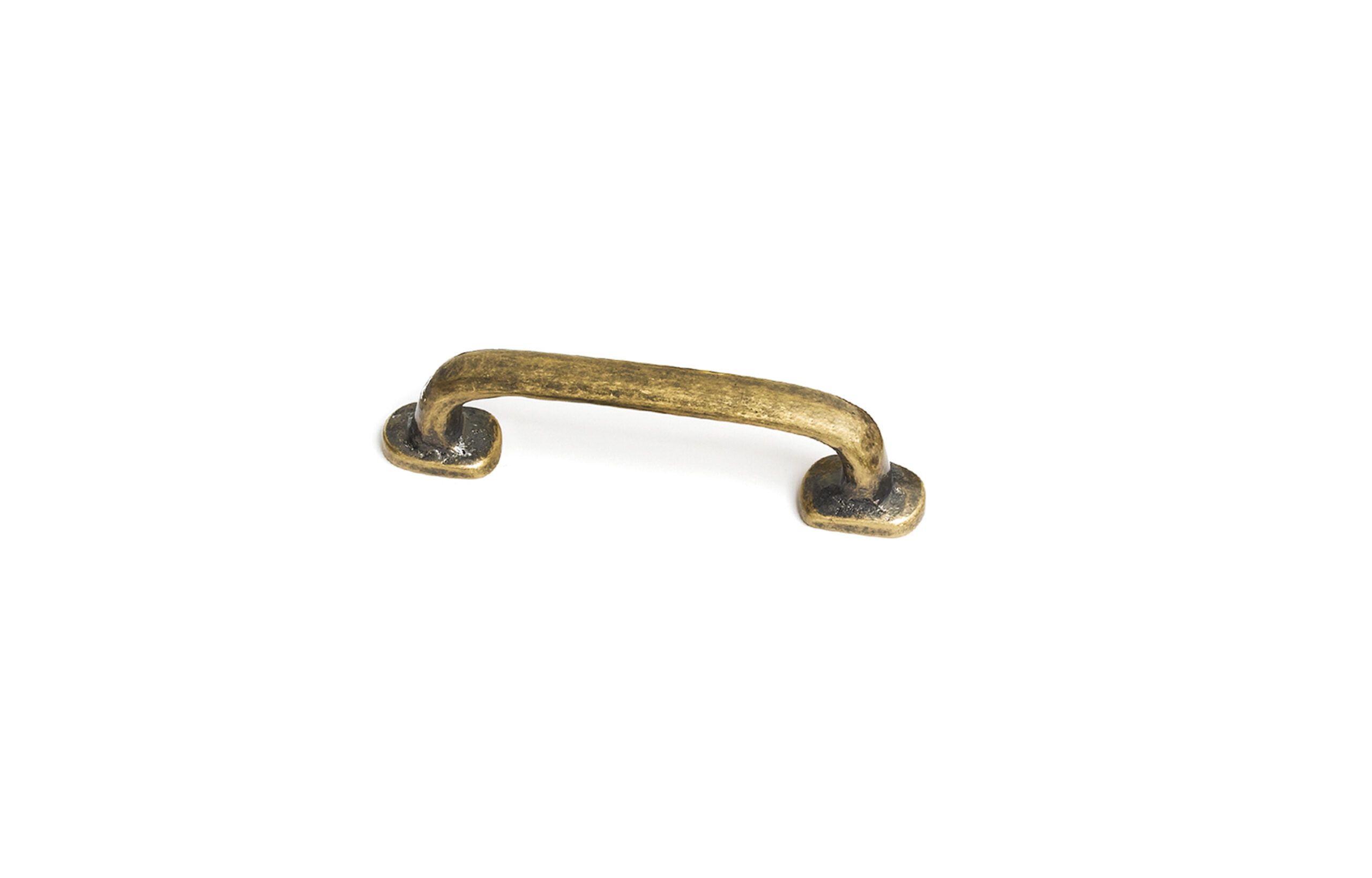
Shown: Legacy distressed pull, about $10; available from Atlas Homewares
Bin Pull
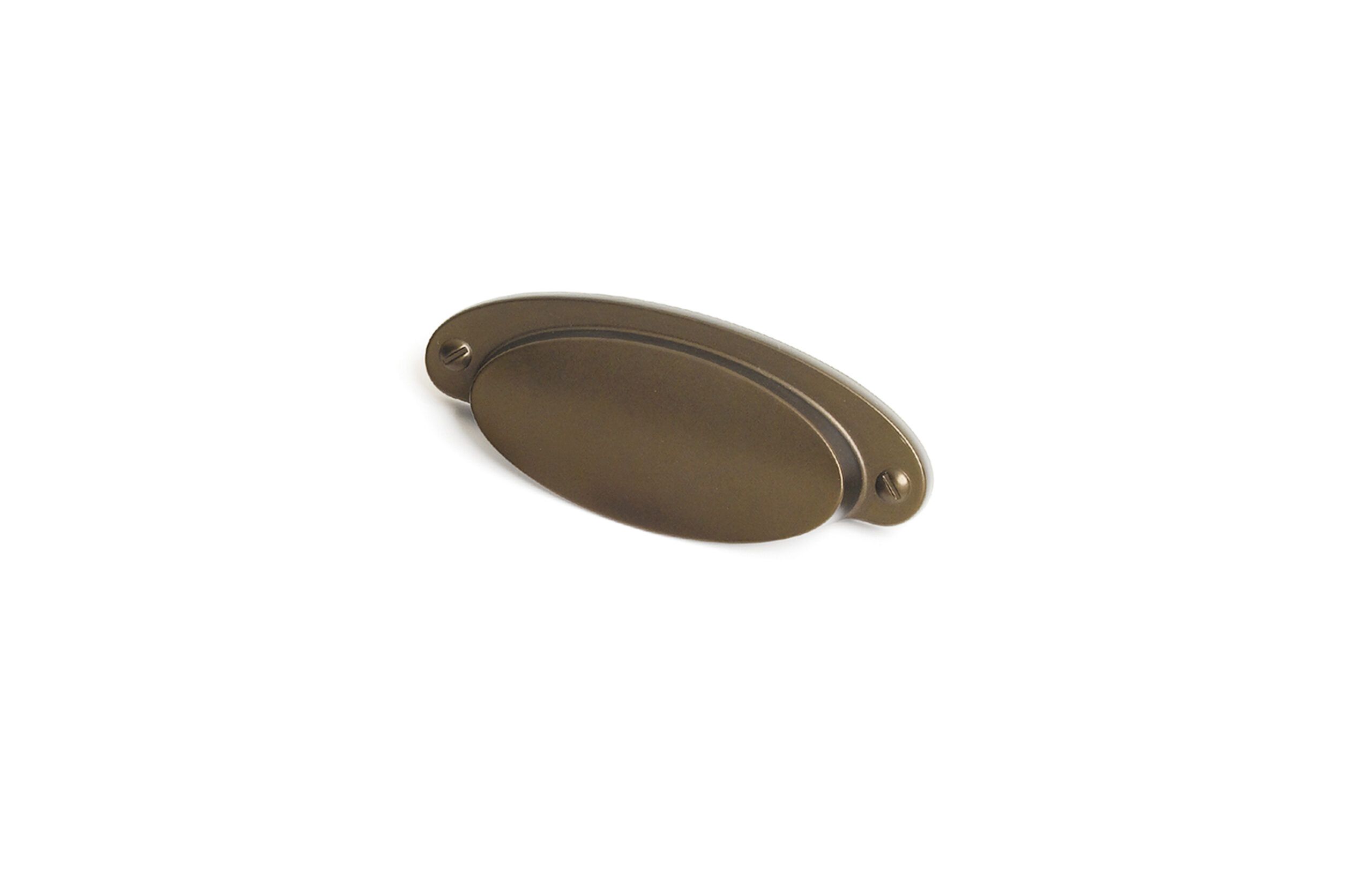
Shown: Top Knobs Cup pull, about $6; available from Home Decor Hardware
Knob
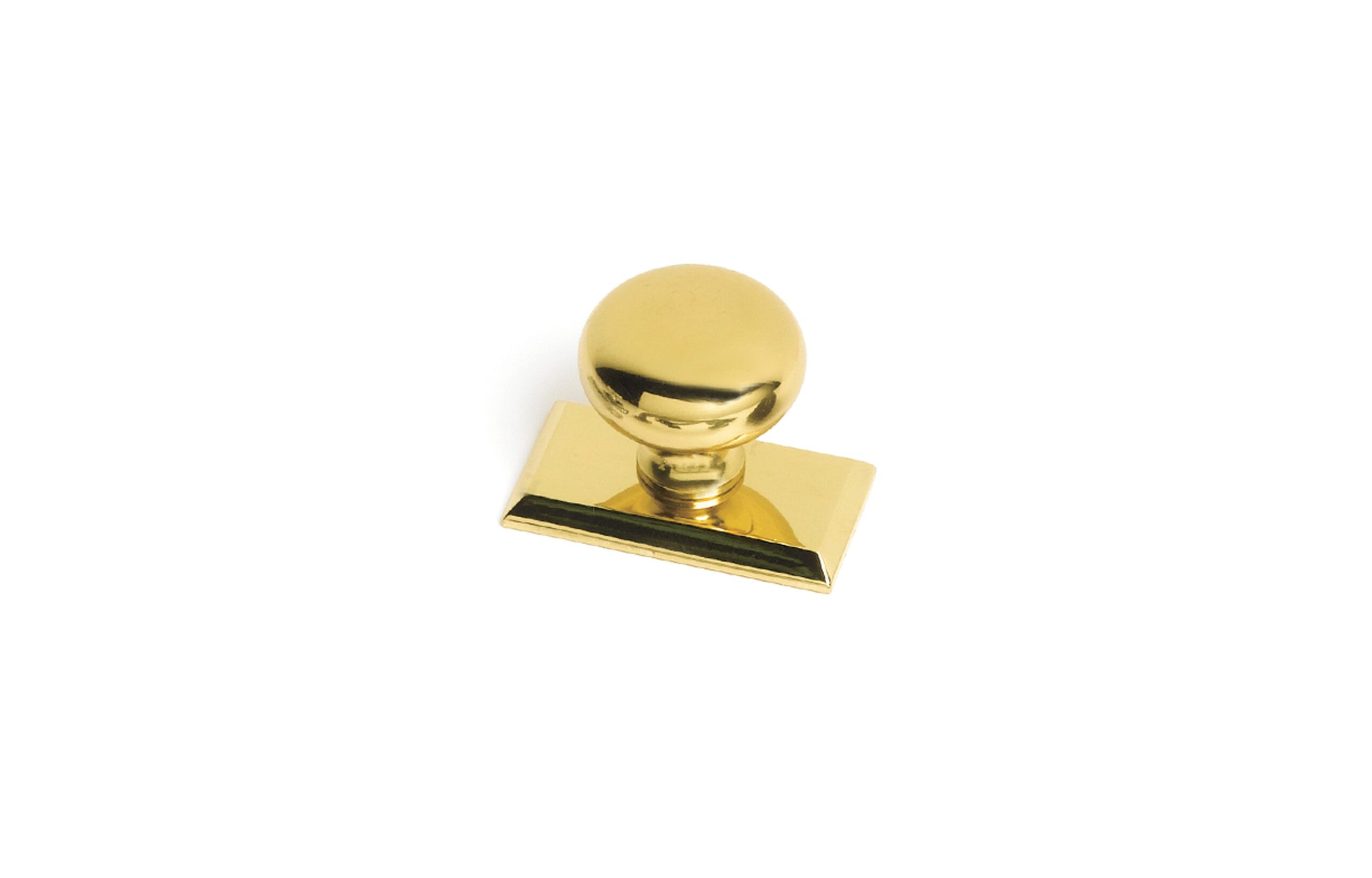
Shown: 1 1/4-inch knob with Craftsman backplate, about $16; available from Restoration.com
Hinges and Drawer Slides
Quality cabinet hinges and slides can improve your cabinets’ usability and lifespan, so it’s worth investing in good hardware. Common hinges and slides include the following:
- Butt hinges: Butt hinges are often used with inset doors for a traditional look. They are visible when the cabinet is closed.
- European (concealed) hinges: This type of hinge is hidden when the door is closed, offering a clean look. They often feature soft-close mechanisms.
- Full-extension drawer slides: This type of slide allows drawers to open completely, providing easy access to contents at the back.
- Soft-close mechanisms: Soft-close mechanisms prevent drawers and doors from slamming shut, reducing wear and tear.
Steeple-Tip Hinge
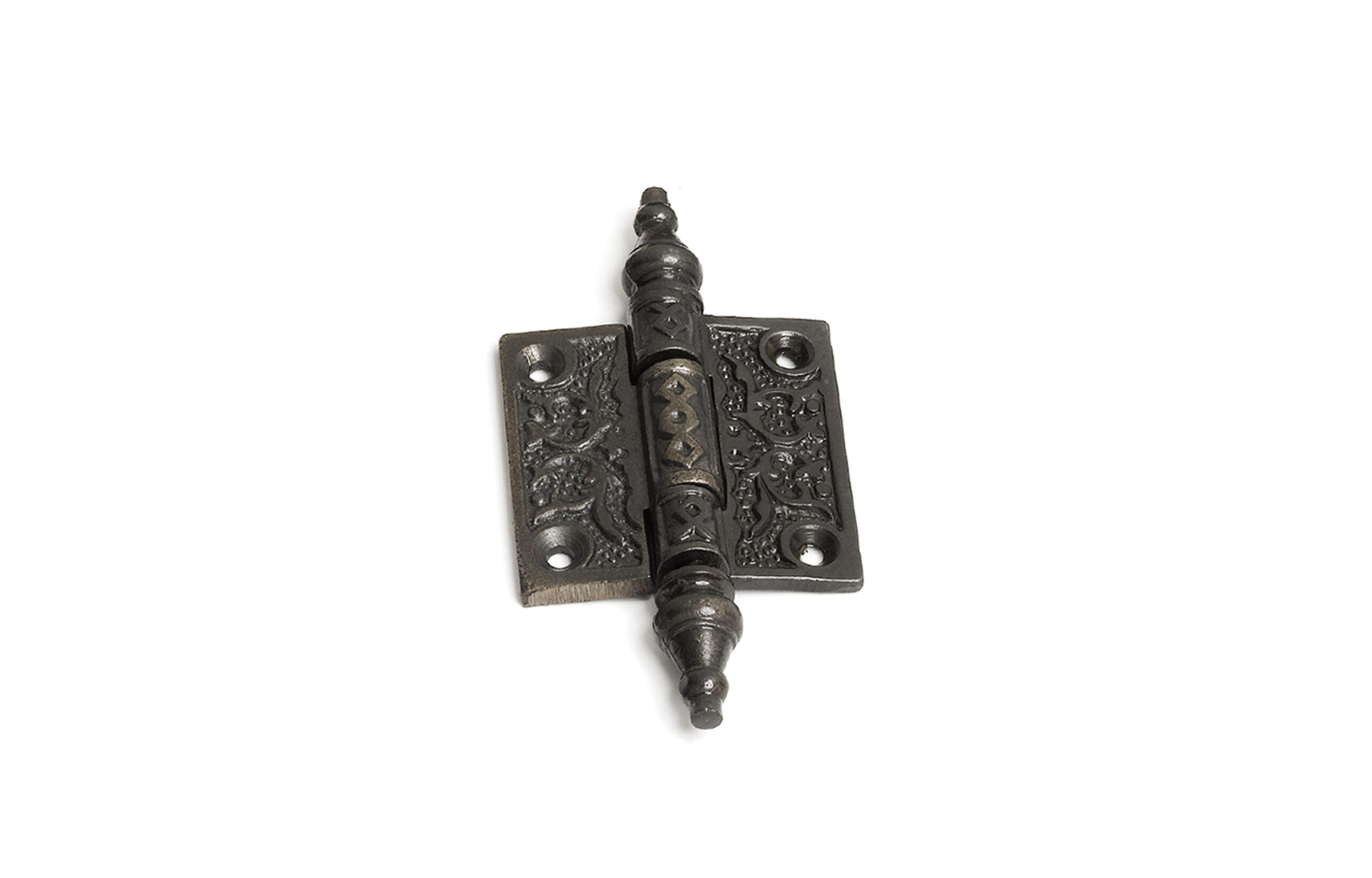
Shown: Victorian hinge, about $12 for two; available from House of Antique Hardware
Strap Hinge
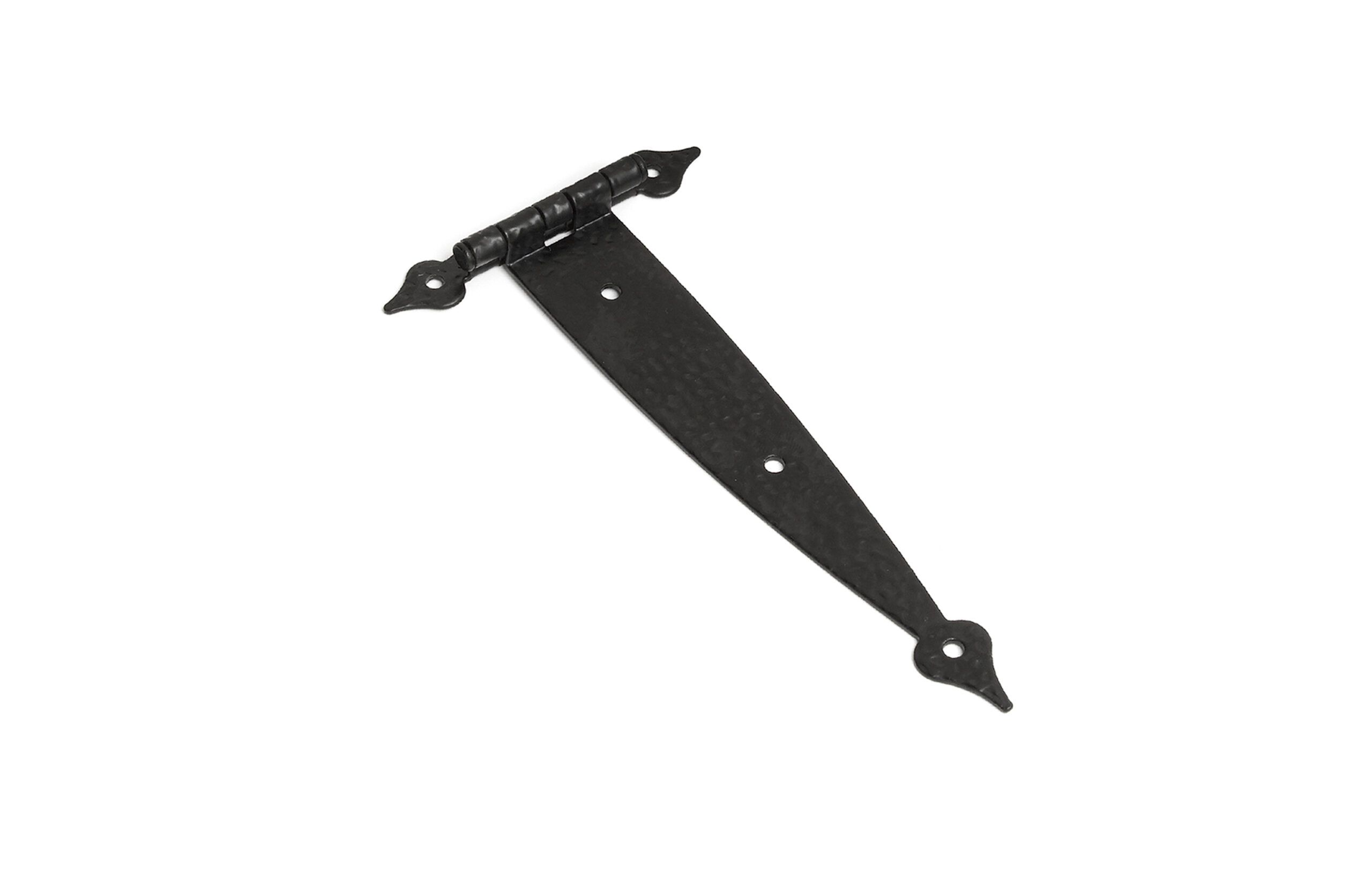
Shown: Amerock’s Colonial strap hinge, about $10; available from Baer Supply Company
Latch
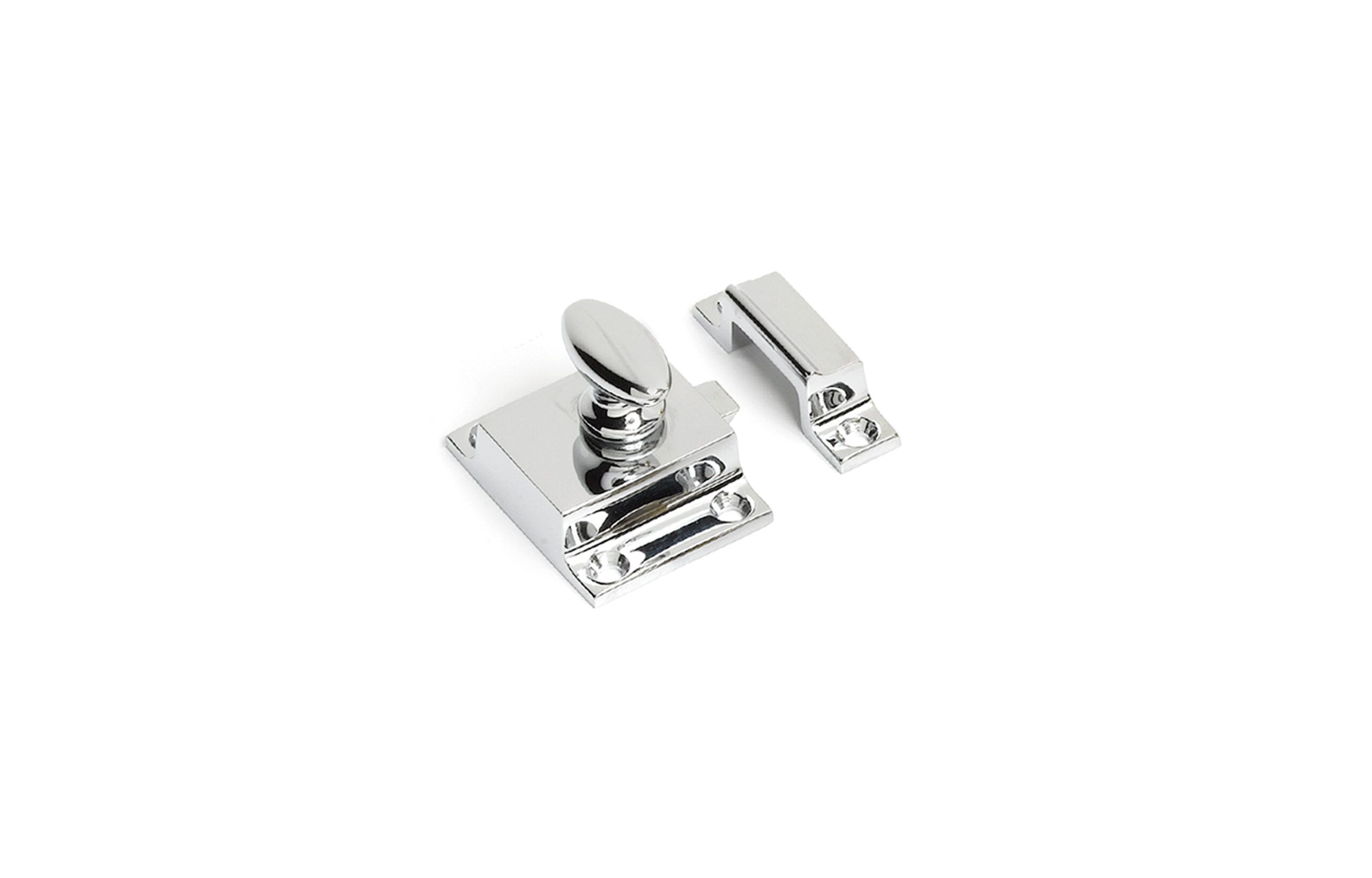
Shown: Cupboard turn oval, about $25; available from Rejuvenation
Planning Your Kitchen Cabinet Layout
A well-planned cabinet layout creates a functional and efficient kitchen. Understanding standard cabinet dimensions and ways to maximize storage will help you plan a kitchen that works well for you.
Standard Cabinet Dimensions
Although you can order custom-sized cabinets, most kitchens use these standard dimensions:
- Base cabinets: Typically 24 inches deep and 36 inches high (including the countertop)
- Countertop height: 36 inches from the floor
- Space between countertop and upper cabinets: Typically 18 inches
- Tall cabinets: Often 84 inches high and used for pantries or appliance storage
- Upper cabinets: Usually 12 inches deep, with heights varying from 30 to 42 inches
Maximizing Storage Space
Consider these ways to maximize your storage space:
- Corner solutions: Use lazy Susans or pull-out systems in corner cabinets to use otherwise hard-to-reach spaces.
- Custom inserts: Incorporate dividers, pull-out trays, and specialized storage units to organize items efficiently.
- Drawer-based lower cabinets: Consider using more drawers in lower cabinets for easier access to items.
- Open shelving: Mix in some open shelves for frequently used items or decorative displays.
- Vertical space: Install cabinets up to the ceiling to maximize storage and create a sleek look.
- Window seats: Add a window seat or install cabinets under an existing one for more storage space.
Window Seat
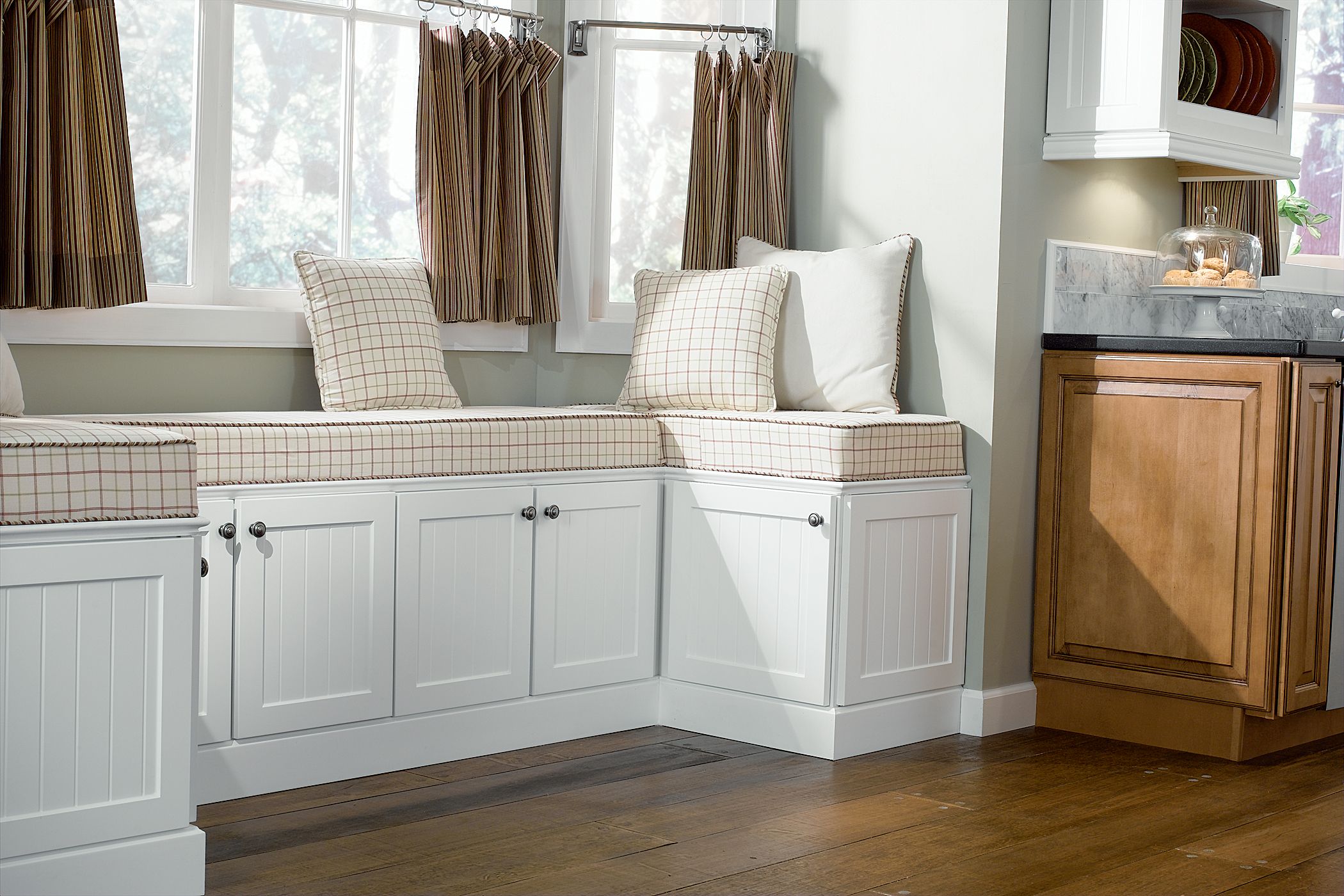
Shown: Stock Annapolis door in white thermofoil over MDF, about $125 per linear foot; available from American Woodmark
Basket Storage
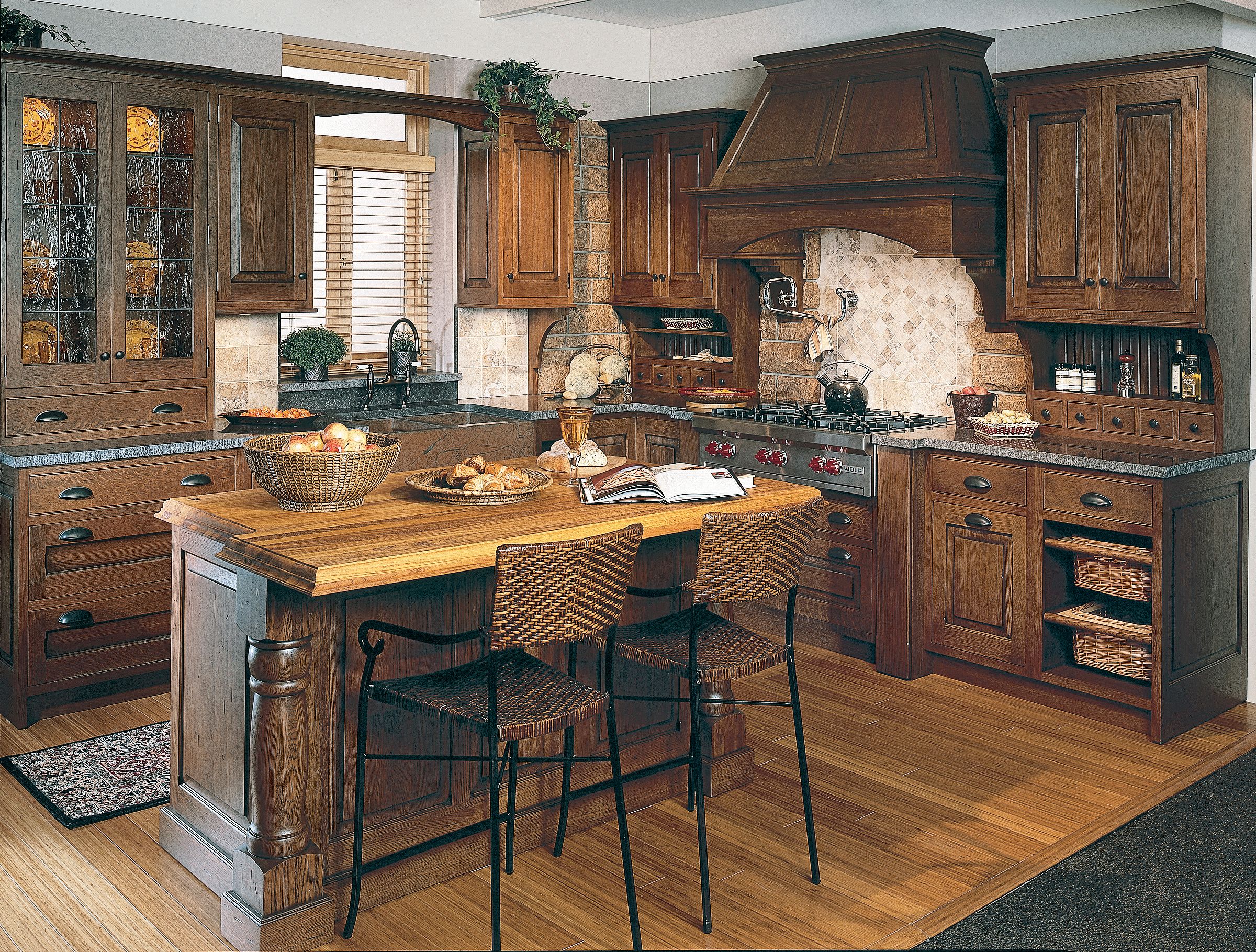
Shown: Custom basket unit in Sierra base in stained quartersawn white oak, about $550; available from Plato Woodwork
Slide-Out Spices
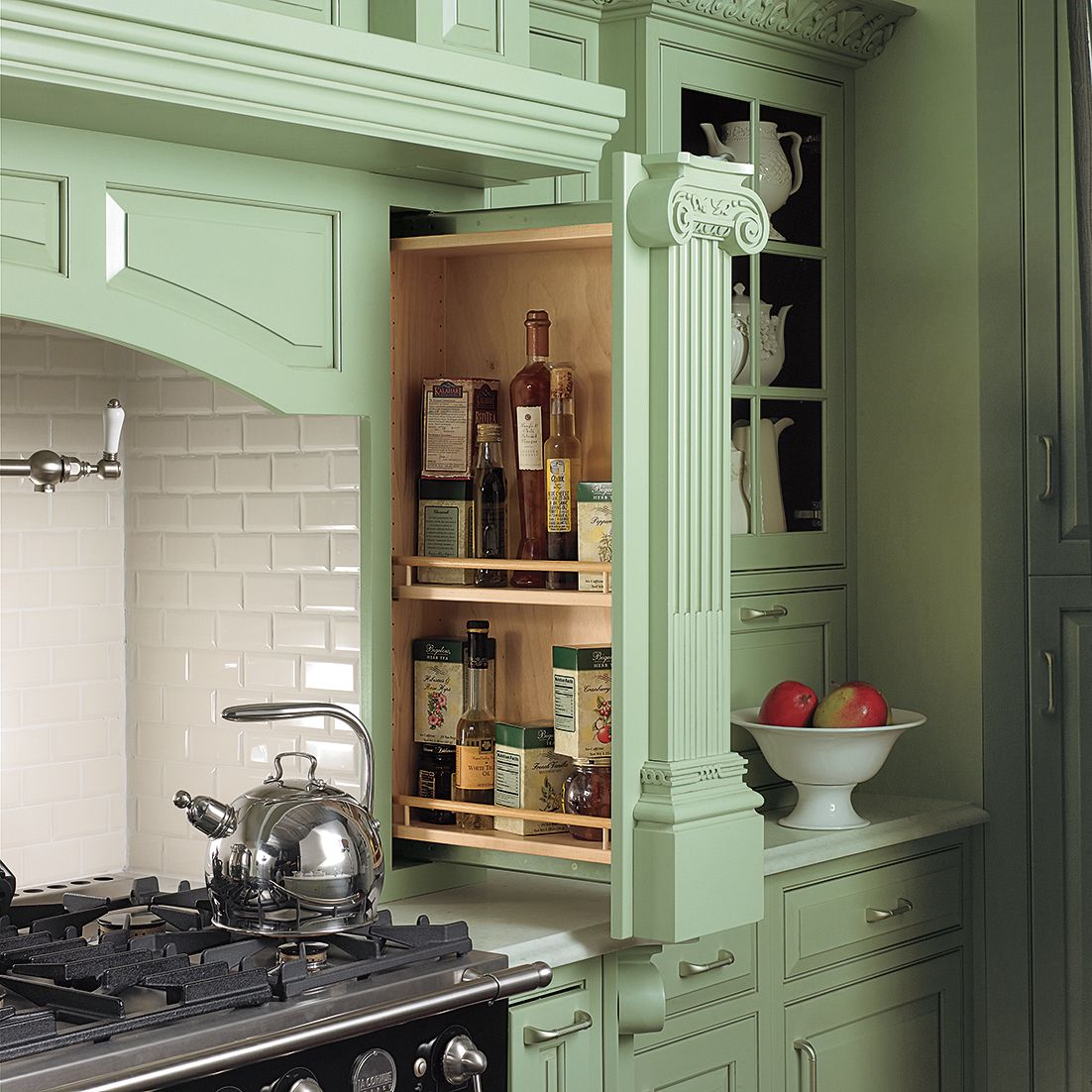
Shown: Custom pull-out spice rack with pilaster detail in painted maple, about $800; available from Plain & Fancy Custom Cabinetry
Wine Storage
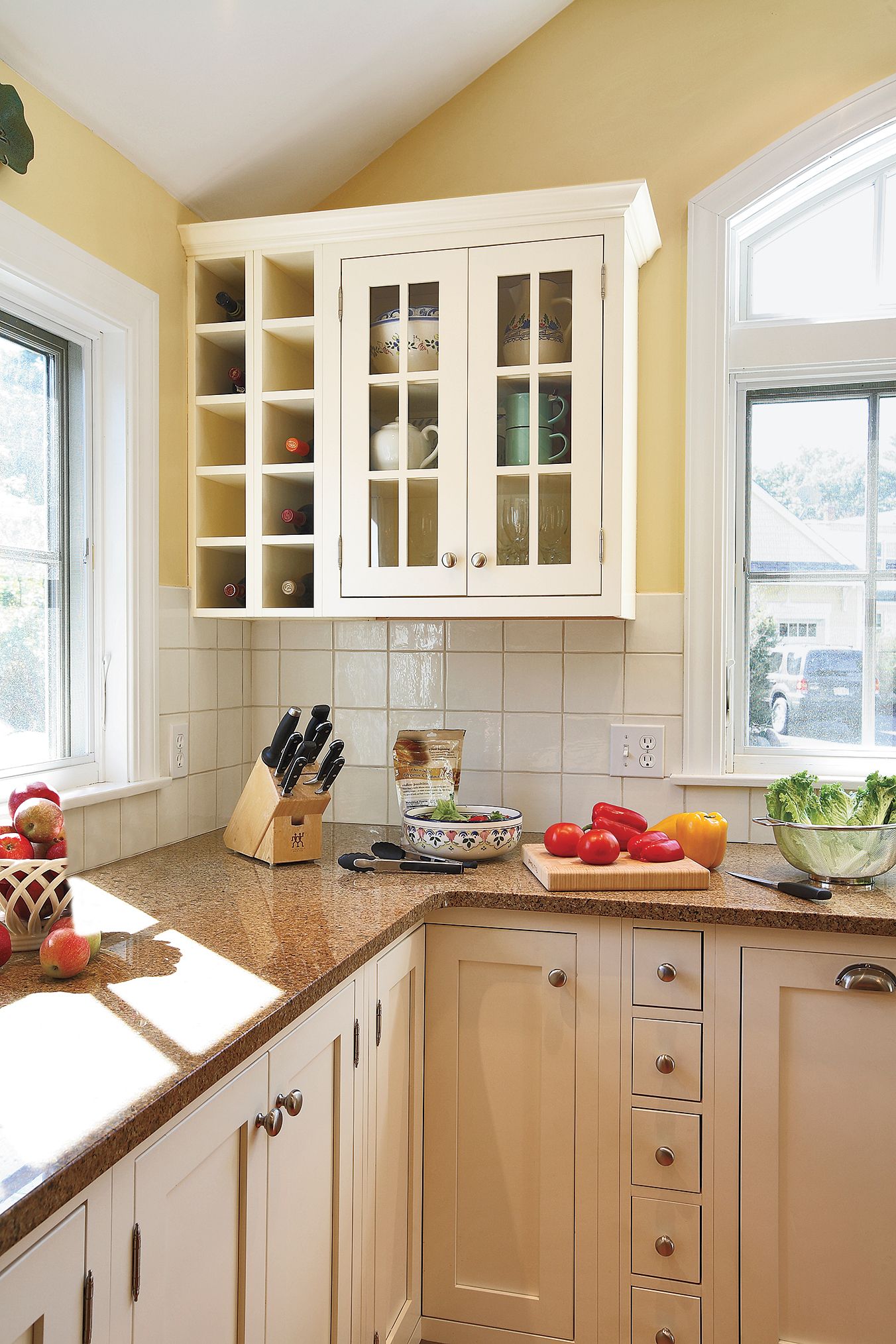
Similar to shown: Semi-custom wall wine rack in painted maple, about $280; available from KraftMaid
Kitchen Cabinet Cost
Cost is one of the most important factors to consider when planning a kitchen cabinet project. Prices vary based on these factors:
- Cabinet type: Stock cabinets are the most affordable, starting at about $35–$81 per linear foot. Semi-custom cabinets range from $90–$650 per linear foot, while custom cabinets can cost about $150–$1,200 per linear foot.
- Construction quality: Cabinets with dovetail joints, soft-close hardware, and plywood boxes typically cost more than those with simpler construction methods.
- Finish: Painted finishes often cost more than stains due to the additional labor.
- Materials: Solid wood cabinets are generally more expensive than those made from engineered wood products like MDF or particleboard.
Budgeting for Cabinets
You should also account for these additional expenses when budgeting for your kitchen cabinets:
- Delivery: Some companies charge for delivery, especially for large or heavy items.
- Installation Costs: Professional installation typically costs 50%–75% of the cabinet price.
- Hardware: Higher-end knobs, pulls, and hinges can greatly increase your budget.
- Modifications: Custom modifications, such as resizing cabinets to fit unique spaces or adding specialty hardware, increase costs.

